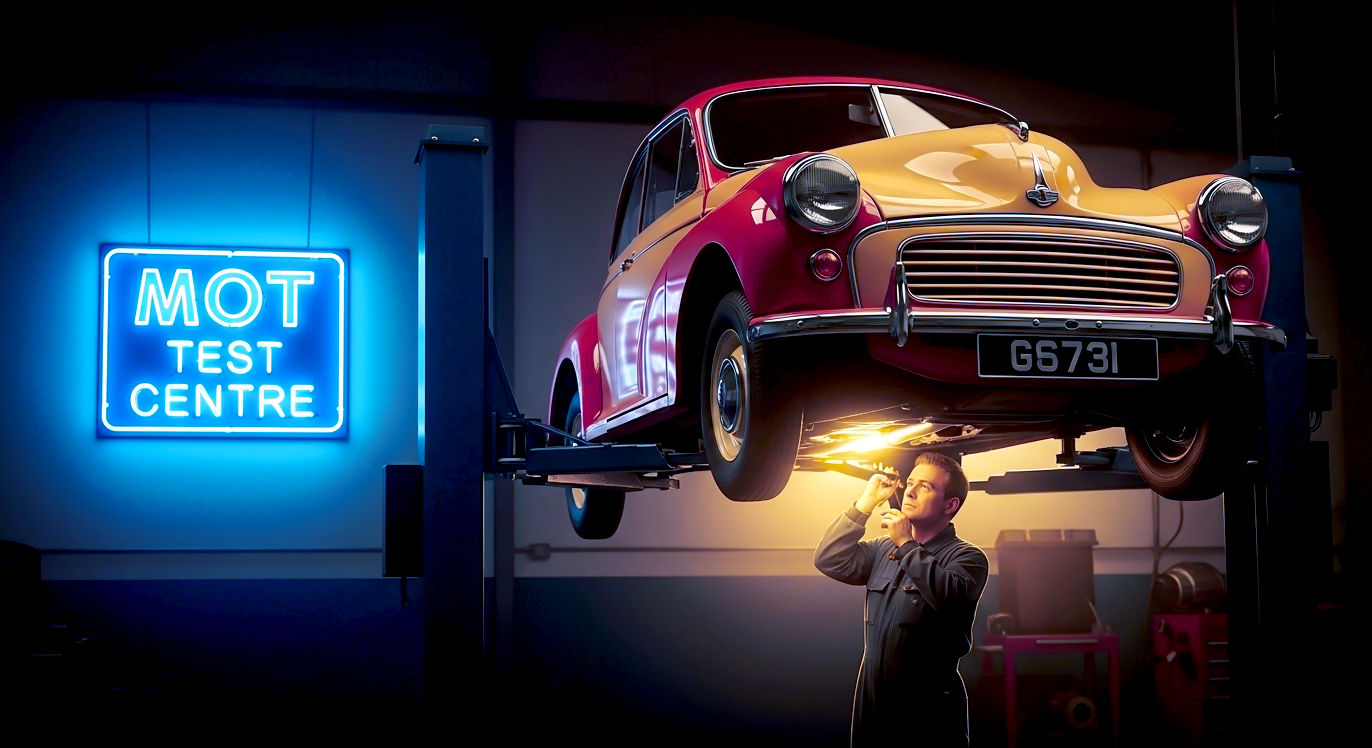The Great British MOT Test: A Journey Through Time
From its creation in 1960 to tackle post-war death traps to the computerised system of today, explore the definitive history of the MOT test in Britain.

This post may contain affiliate links. If you make a purchase through these links, we may earn a commission at no additional cost to you.
It’s a uniquely British ritual. That yearly appointment, often met with a sense of mild dread, where you hand over your car keys to a trusted mechanic and hope for the best. For millions, the MOT test is a familiar, if sometimes stressful, part of owning a car. It’s the gatekeeper to another year of legal driving, a certificate that declares your vehicle is, at least for a day, fit for the road.
But where did this annual inspection come from? It wasn’t born out of a desire to frustrate motorists or to keep garages busy. The MOT test has a fascinating history, a story that mirrors the evolution of the car itself and reflects a nation’s growing concern for road safety. It’s a tale of political will, tragic accidents, and technological leaps. From a simple check on post-war bangers to a complex digital diagnosis of modern cars, this is the story of how the MOT became a cornerstone of British motoring.
Part 1: The Wild Roads of Post-War Britain
To understand why the MOT test was created, you have to picture Britain’s roads in the 1950s. The country was shaking off the dust of the Second World War. Cars, once a luxury, were becoming more affordable. The Morris Minor, the Austin A30, and the Ford Anglia started filling the streets, bringing a newfound sense of freedom to ordinary families.
But this new age of motoring had a dark side. There were no mandatory safety checks. A car could be driven until it literally fell apart. Bald tyres, failing brakes, and rusty steering components were terrifyingly common. Many vehicles on the road were pre-war models, kept running with spit and sawdust engineering. The result was carnage. In 1959 alone, over 6,500 people were killed on Britain’s roads, a shocking figure when you consider there were far fewer cars than there are today.
The government knew something had to be done. The public was alarmed, and newspapers were full of stories about horrific accidents caused by unroadworthy vehicles. The stage was set for a radical idea: a compulsory vehicle inspection.
Part 2: The Birth of the Test (1960)
The man who championed this change was Ernest Marples, the Minister of Transport. A controversial but energetic figure, Marples was determined to modernise Britain’s transport system. He’d already overseen the opening of the first stretch of the M1 motorway in 1959. Now, he turned his attention to vehicle safety.
Using powers from the Road Traffic Act of 1956, Marples introduced a mandatory test for all vehicles over ten years old. It was officially called the Ministry of Transport test, which quickly became shortened to the ‘MOT test’.
The first MOT test was introduced on 12 September 1960.
It was a simple affair, especially by today’s standards. The test, which cost 14 shillings (equivalent to about £15 today) including the certificate, only covered three key areas:
- Brakes: Were they effective enough to stop the car safely?
- Steering: Was it functioning correctly without excessive play?
- Lights: Did the headlights and taillights work as they should?
The test was initially voluntary for the first month to allow garages and motorists to get used to the idea. But from October, it became compulsory. Garages that wanted to become official test centres had to apply for a licence and be approved by the Ministry. These chosen garages were marked by the now-famous blue sign with three white triangles. This symbol, still in use today, quickly became a familiar sight on high streets and industrial estates across the country.
The public reaction was mixed. Many drivers saw it as a sensible safety measure, while others complained it was an unnecessary expense and an intrusion by the state. But the results spoke for themselves. In the first year, a significant number of cars failed the test, proving just how many dangerous vehicles had been lurking on the roads.
Part 3: Evolution and Expansion (1961-1980s)
The “ten-year test,” as it was informally known, was just the beginning. The government soon realised that ten years was too long to wait to check a car’s safety. Many vehicles became dangerously worn out long before their tenth birthday.
Closing the Gap
The first major change came quickly. In 1961, the age at which a car needed its first MOT was slashed from ten years to seven years. The roads were getting safer, but the problem of defective vehicles hadn’t gone away.
Then, in 1967, another landmark change was made. The requirement was tightened again, this time to three years. This “three-year test” rule has remained the standard in Great Britain ever since. It was a recognition that modern cars, while more reliable, were also faster and more complex, and that regular checks were essential.
What Was Checked?
The list of items inspected during the MOT also grew steadily. The simple check of brakes, steering, and lights was no longer enough.
- 1968: A tyre check was added. The test now made sure tyres had enough tread depth and were free from serious cuts or bulges. This was a huge step forward, as worn tyres were a major cause of accidents.
- 1977: The test expanded again to include checks on windscreen wipers and washers, horn, indicators, and the condition of the bodywork and chassis. Rust, the great enemy of cars from this era, could now lead to an MOT failure if it was deemed structural.
- 1983: The famous MOT certificate, the VT20, was changed from a handwritten document to a computerised one, though the system remained offline.
These changes reflected the increasing complexity of cars and a deeper understanding of vehicle safety. The MOT was evolving from a basic mechanical check into a comprehensive health check for the whole vehicle.
Part 4: The Digital Revolution (1990s-2010s)
For decades, the MOT system relied on paper. Garages filled out certificates by hand, and records were stored in filing cabinets. This system worked, but it was open to mistakes and, more seriously, fraud. It was possible for criminals to issue fake MOT certificates for unroadworthy cars, putting dangerous vehicles back on the street.
The government knew a digital solution was needed. The plan was to create a centralised database that would connect every MOT testing station in the country.
The MOT Computerisation Scheme
After years of planning and trials, the MOT Computerisation Scheme was officially launched in April 2005. It was a massive undertaking. Every one of the roughly 20,000 MOT testing stations had to be equipped with a computer connected to a central database run by the Vehicle and Operator Services Agency (VOSA), which is now the Driver and Vehicle Standards Agency (DVSA).
This new system changed everything:
- Instant Records: When a car passed or failed its MOT, the result was instantly uploaded to the central database.
- Ending Certificate Fraud: It became virtually impossible to create a fake MOT certificate, as police and the public could check the database in real-time. The new A4-style certificates were printed on plain paper, as the security was now in the digital record, not the document itself.
- Access to MOT History: A huge benefit for car buyers was the creation of the online MOT history checker. For the first time, anyone could go online, enter a vehicle’s registration number, and see its entire MOT history – including passes, fails, and any advisory notes. This made it much harder for dishonest sellers to hide a car’s problematic past.
The transition wasn’t without its teething problems. Some garage owners, used to pens and paper, struggled with the new technology. There were system crashes and complaints about the cost. But within a few years, the computerised system was running smoothly and had fundamentally improved the integrity and transparency of the MOT test.
Part 5: The Modern MOT (2018 onwards)
As cars have become more advanced, the MOT test has had to keep pace. The biggest shake-up in recent years came in May 2018, when a new set of rules was introduced to bring the UK in line with a European Union directive (which the UK retained after Brexit).
New Fault Categories
The most significant change was the introduction of new fault categories. Instead of a simple pass or fail, defects are now categorised as:
- Minor: These faults are not serious enough for the car to fail, but they should be repaired soon. They are recorded on the certificate, similar to the old “advisories.”
- Major: This is a failure. The fault is serious and could affect the vehicle’s safety or have an impact on the environment. It must be repaired immediately.
- Dangerous: This is also a failure, and it’s the most serious category. A “Dangerous” fault means the vehicle poses a direct and immediate risk to road safety. A car with a dangerous fault cannot be driven on the road, not even to a garage for repairs, until the fault is fixed.
New Items on the Checklist
The 2018 changes also added new items to the inspection, reflecting the technology found in modern cars:
- Diesel Particulate Filters (DPF): The test now includes a strict check to see if the DPF has been tampered with or removed. If it has, it’s an automatic major fault.
- Brake Fluid: The brake fluid is checked to ensure it hasn’t been contaminated.
- Daytime Running Lights: These became a mandatory check for cars that have them fitted as standard.
- Reversing Lights: These are now checked on all cars first used from September 2009.
The Classic Car Exemption
Another key change in 2018 was the new rule for classic cars. Vehicles that are over 40 years old and have not been “substantially changed” are now exempt from needing an MOT. The logic is that classic car owners are typically enthusiasts who maintain their vehicles to a high standard. However, the exemption remains a topic of debate, with some arguing that any car on a public road should be independently checked for safety.
Part 6: The MOT and British Culture
The MOT test is more than just a legal requirement; it’s woven into the fabric of British life. It has its own language, its own rituals, and its own place in our national conversation.
The Annual Dread
For many drivers, the approach of the MOT date brings a familiar feeling of anxiety. Will it pass? What expensive problems will the mechanic find this time? The phrase “It’s due for its MOT” is universally understood as a potential source of stress and unexpected bills. This yearly gamble is a shared experience that connects drivers across the country.
The Trusted Local Garage
The MOT has also shaped our relationship with mechanics. Finding a good, trustworthy garage is a rite of passage for a car owner. We rely on their expertise to guide our cars through the test and to give us honest advice. The MOT test centre is a cornerstone of local communities, a place of expertise where the fate of our daily transport is decided.
A Barometer for a Used Car
In the world of second-hand cars, the MOT certificate is king. A car with a long, clean MOT history is seen as a safe bet. A recent pass with no advisories is a major selling point. Conversely, a car that’s “sold with no MOT” is a red flag, usually indicating it needs significant and costly repairs. The online MOT history checker has empowered buyers, giving them a powerful tool to weed out neglected vehicles.
Part 7: The Future of the MOT
The car is changing faster now than at any time in the past 100 years. The rise of electric vehicles (EVs) and the development of autonomous driving technology present new challenges for the MOT test. How can a test designed for the petrol engine era adapt to the age of the computer on wheels?
Testing Electric Vehicles (EVs)
EVs don’t have emissions, so a key part of the current test is irrelevant. However, they do have other components that need checking. The DVSA has already adapted the test to include checks on the condition of the high-voltage battery and its wiring. But other challenges remain. EVs are much heavier than petrol cars, which can lead to faster tyre and suspension wear. They also use regenerative braking, which means the conventional friction brakes are used less often and can be more prone to seizing from lack of use. The MOT of the future will need to focus more on these areas.
Advanced Driver-Assistance Systems (ADAS)
What about systems like adaptive cruise control, lane-keeping assist, and automatic emergency braking? These safety-critical systems rely on an array of sensors and cameras. If one of these sensors is misaligned, even by a tiny amount, the system could fail at a critical moment. Currently, the MOT only checks for warning lights related to these systems. In the future, test centres may need sophisticated equipment to calibrate and test the ADAS functions themselves.
The Debate Over Frequency
The question of how often the MOT should be done is a recurring debate. Some argue that as modern cars are more reliable, moving to a biennial test (every two years) after the first one would save drivers money without compromising safety. Others, including many safety groups and the garage industry, argue that the annual test is crucial for catching dangerous faults early. In 2023, the government consulted on changing the first test from three years to four, but the plan was ultimately scrapped after widespread opposition. For now, the annual test remains.
Conclusion: A Legacy of Safety
From its simple beginnings in a post-war world of rattling engines and failing brakes, the MOT test has become one of the most successful road safety initiatives in British history. It has professionalised the garage industry, given consumers vital protection when buying used cars, and, most importantly, saved countless lives.
The blue sign with the three triangles is more than just a logo for a garage. It’s a symbol of a promise – a promise that the vehicles on our roads meet a minimum standard of safety. The test will continue to adapt to new technologies, but its core purpose will remain the same: to make our journeys safer. So next time you drop your car off for its annual check-up, remember you’re taking part in a great British tradition, one that has been keeping us safe for over 60 years.
Further Reading
For those interested in exploring the topic further, here are some highly respected resources:
- GOV.UK MOT Information: The official government source for all rules and information regarding the MOT test.
- DVSA (Driver and Vehicle Standards Agency): The executive agency that sponsors the MOT scheme provides detailed guidance and statistics.
- The RAC – MOT Test History: A good overview from a respected motoring organisation.
- The AA – MOT Changes: Detailed explanations of the latest updates to the MOT test.






